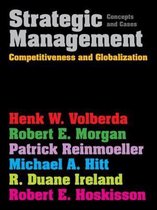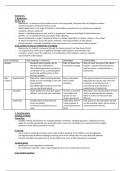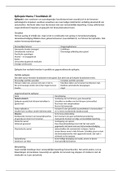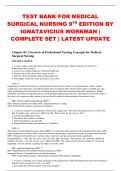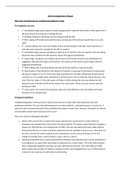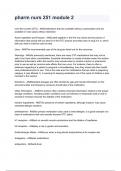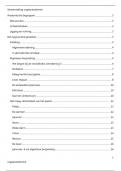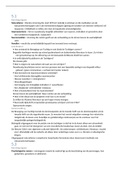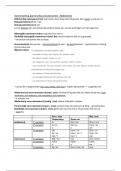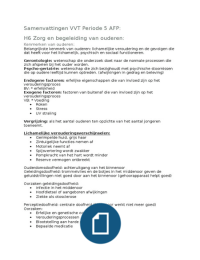Strategy & organisation
Chapter 1 – Strategic management and strategic competitiveness
Strategic Competitiveness = Achieved when a firm successfully formulates and implements
a value-creating strategy.
Strategy = An integrated and coordinated set of commitments and actions designed to
exploit core competencies and gain a competitive advantage.
Competitive advantage = A firm has this when it implements a strategy competitors are
unable to duplicate or find too costly to try to intimate.
Above-average returns = Are returns in excess of what an investor expects to earn from
other investments with a similar amount of risk.
Risk = An investor’s uncertainty about the economic gains or losses that will result from a
particular investment.
Average returns = Are returns equal to those an investor expects to earn from other
investments with a similar amount of risk.
Strategic management process = the full set of commitments (verplichtingen), decisions
and actions required for a firm to achieve strategic competitiveness and earn above-average
returns.
Hypercompetition (hyperconcurrentie) = A term often used to capture the realities of the
competitive landscape.
Global economy = An economy in which goods, services, people, skills and ideas move
freely across geographic borders.
GDP = Gross domestic product (BBP)
Globalization = The increasing economic interdependence among countries and their
organizations as reflected in the flow of goods and services, financial capital and knowledge
across country borders.
Technological diffusion (verspreiding) = The rate at which new technologies become
available and are used. (hoe lang duurt het voordat iedereen een tv heeft bv) algemeen
This is due the speed of the market that comes with innovative products and another reason
is that it now may take only 12 to 18 months for firms to gather information about their
competitors.
Perpetual (eeuwige) innovation = Describes how rapidly and consistently new information-
intensive technologies replace older ones. (computersystemen)
Disruptive (verstorend) technologies = Can destroy the value of an existing technology
and create new markets. (iphone 7 destroys the market of iphone 6)
,Knowledge = Is gained through experience, observation and inference.
Strategic flexibility = A set of capabilities used to respond to various demands and
opportunities existing in a dynamic and uncertain competitive environment.
The I/O model of above average returns explains the external environment’s dominant
influence on a firm’s strategic options. The model specifies that the industry or segment of an
industry in which a company chooses to compete has a stronger influence on performance
than do the choices managers make inside their organizations.
4 underlying assumptions according to the I/O model
- The external environment is assumed to impose pressures and constraints that
determine the strategies that would result in above-average returns.
- Most firms competing within an industry or within a segment of that industry are
assumed to control similar strategically relevant resources and to pursue similar
strategies in light of those resources.
- Resources used to implement strategies are assumed to be highly mobile across
firms, so any resource differences that might develop between firms will be short-
lived.
- Organizational decision makers are assumed to be rational and committed to acting
in the firm’s best interests, as shown by their profit-maximizing behaviours.
The resource-based model of above-average returns assumes that each organization is a
collection of unique resources and capabilities. The uniqueness of these two is the basis for
a firm’s strategy and it’s ability to earn above-average returns.
Resources = Inputs into a firm’s production process, such as capital equipment, the skills of
individual employees, patents, finances, and talented managers.
Capability = The capacity for a set of resources to perform a task or an activity in an
integrative manner.
Core competencies = Capabilities that serve as a source of competitive advantage for a
firm over its rivals.
Vision = A picture of what the firm wants to be and, in broad terms, what it wants to
ultimately achieve.
Vision is ‘big picture’ thinking with passion that helps people feel what they are supposed to
be doing in the organization.
Mission = Specifies the business or businesses in which the firm intends to compete and the
customers it intends to serve.
The vision is the foundation (grondlaag) of the firm’s mission. The mission is more concrete
than its vision.
20% of a firm’s profitability is explained by industry structure (e.g. bv. I/O model).
36% of a firm’s profitability is attributed to internal firm characteristics and strategic actions.
44% unexplained
, Stakeholders = The individuals and groups who can affect the firm’s vision and mission, are
affected by the strategic outcome the firm achieves through its operations, and who have
enforceable claims on the firm’s performance.
Stakeholders can be divided into three groups:
1. Capital market stakeholders (shareholders and the major suppliers of a firm’s capital)
2. Product market stakeholders (primary customers, suppliers, host communities)
3. Organizational stakeholders (employees, managers, nonmanagers)
Strategic leaders = People located in different parts of the firm using the strategic
management process to help the firm reach its vision and mission.
Organizational culture = This refers to the complex set of ideologies, symbols and core
values that are shared throughout the firm and that influence how the firm conducts
business.
Profit (winst) pool = This entails the total profits earned in an industry at all points along the
value chain.
Four steps for identifying profit pools:
1. Define the pool’s boundaries
2. Estimate the pool’s overall size
3. Estimate the size of the value-chain activity in the pool
4. Reconcile the calculations
Chapter 2 – The external environment
1. General environment = Composed of dimensions in the broader society that
influence an industry and the firms within it.
2. Industry environment = Is set of factors that directly influence a firm and its
competitive actions and competitive responses: the threat of new entrants, the power
of suppliers, the power of buyers, the power of product substitutes, the intensity of
rivalry among competitors.
3. Economic environment = Refers to the nature and direction of the economy in
which a firm competes or may compete.
Opportunity = A condition in the general environment that, of exploited, helps a company
achieve strategic competitiveness.
Opportunity is an opposite of a threat in the external environment.
Threat = A condition in the general environment that may hinder a company’s efforts to
achieve strategic competitiveness.
1. Demographic segment = Concerned with a population’s size, age structure,
geographic distribution, ethnic mix and income distribution.
2. Political/legal segment = The arena in which organizations and interest groups
compete for attention, resources, and a voice in overseeing the body of laws and
regulations guiding the interactions among nation as well as between firms and
various local governmental agencies.

